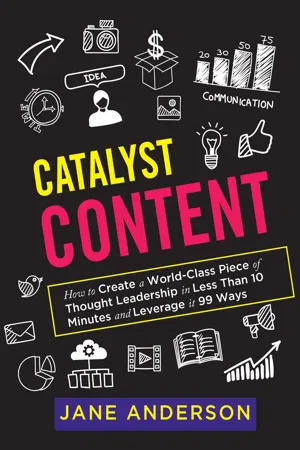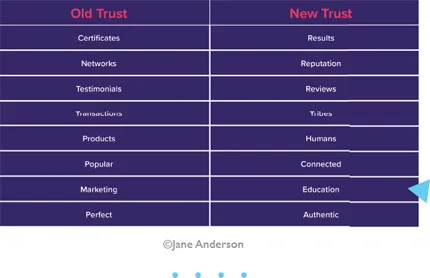![]()
“Content Marketing is the only marketing left.”
– Seth Godin
Content marketing is the only marketing left. Yet, we still struggle to implement content that creates engagement and drives change in our businesses and practice. That is where this book comes in.
In Catalyst Content, we’re going to meet this need for content marketing head on. As thought leaders, experts, business owners and entrepreneurs, it is essential that we get our messages out to our audiences. We’ll discuss the barriers that stop us from doing just that. Then we’ll talk about the actual process of content creation, from ideation to distribution.
But most importantly, we’ll dive deep into the processes, systems and mindsets that help you take your content from noise lost in the internet abyss to catalyst content, that is not just heard, but repeated, and that helps you to truly embrace your role as an expert, a thought leader and a changemaker in your industry.
But first, let’s talk about why content is important.
Why does Content Matter?
In late January 1998, then US president Bill Clinton, gave his infamous speech about his dealings with a White House intern, 22-year-old Monica Lewinsky. The scandal had rocked Clinton’s reputation, and in that speech he stated, “I did not have sexual relations with that woman.” We now know he was lying, and with that statement came a watershed moment – that a prestigious authority, a president, would lie.
Around the same time, the internet became accessible to the public. Suddenly we had access to so much more information (and misinformation), and the way people consumed information and made decisions quickly evolved – and continues to evolve.
Today, we can “Google” symptoms when we feel unwell, search for people’s background information and find out more about any subject than ever before. This has also created increased transparency. Instead of the media filtering conversations, social media has given the average person a voice.
As a result, we have become aware of others’ opinions. This has led us to question “whom do I trust?”
Content helps us understand whom we can trust
When trying to identify whom we can trust, we no longer look for certificates on walls. We look for social proof, such as an online presence and customer reviews on Google and Facebook. We’re trying to find out who has the real influence, the real power and is the real deal.
As a result, leaders and businesses have moved away from formal ways of building trust to far more socially connected and socially proven methods of building trust.
We’re living in a digital-first world
In his book Ctrl Alt Delete, Mitch Joel discusses the term “digital first”. He reveals the five fundamental movements organisations must embrace to future-proof themselves – or risk going out of business. One of these shifts is the fact that now, the first place your brand and business are validated is online. The internet has the power to make or break your chances of success.
Serial entrepreneur, Gary Vaynerchuk, is an excellent example of how to cultivate a successful business by leveraging digital media. Born in the Soviet Union in 1975, Gary Vee, as he’s known, immigrated to the United States in 1978. From those humble beginnings, his father went on to own a liquor store in New Jersey.
In the early days of the digital-first world, Gary Vee could see the vast potential of his father’s business. After graduating from college, Gary Vee transformed the liquor shop into a retail wine store, which he named the “Wine Library”. In 2006, he started a daily video blog, Wine Library TV. This hugely popular webcast turned him into an internet celebrity. It attracted 90,000 viewers a day and led to a flurry of TV and speaking engagements. In just six years, Gary Vee grew the family business from $1 million a year to a whopping $50 million a year!
As you can see, traditional marketing has been blown out of the water. We’re no longer restricted to cold calling and setting up meeting after meeting to generate leads and sales. Digital marketing has opened an array of cost-effective avenues for self-promotion and lead generation. Sales are now about leveraging your social networks, engaging with people online and educating.
This is, essentially, the social sales model:
Today, the businesses and entrepreneurs that make the most impact on their audiences are role models. They’re trusted advisers who create tribes – powerful online communities that help their brands grow. They educate and provide solutions. They’ve jumped on board the social sales train and have embraced the connection economy whole-heartedly. Because if you don’t embrace change, you get left behind.
But, as leaders, we can’t rest on our laurels. We must build on this massive sales reform and look to the future. We must become trusted industry ambassadors; thought leaders who engage meaningfully with our followers, share generously our expertise and regard our audiences not just as leads or dollar signs, but as lifetime partnerships.
Sometimes though, we struggle to get out content. It can, at times, seem like there’s so much content out there already, and just so much noise, that it’s hard to keep up. It can seem like it’s impossible to make our own message heard. But the data disagrees. People are consuming more content than ever, and we’re producing less.
People are consuming more content than ever
The data tells us that people are actually consuming more content than ever, but we’re creating less content than the market can consume and less than we have in the past. This is particularly true in Australia. We’re starting to pick up, but we’re not creating as much as other countries like the US.
We’ve got some challenges in Australia, such as the “tall poppy syndrome”. We struggle to put ourselves and our ideas out there for fear that people might see us as believing we know best or are “better than them”. But the reality is we need to be a tall poppy – we need to be seen.
Content marketing is a major growth industry. In 2015, the content marketing industry was a $118 billion industry, In 2021, the content marketing industry is expected to be a $421 billion industry. That is extraordinary growth. People are starting to capitalise on this growth, recognising that content marketing is the key to getting in front of clients. We need to be doing the same.
Business growth in a social-first world
Business growth today works quite differently to how it used to work years ago. It used to be about cold-calling, sales demonstrations and qualifying leads. But today it’s all about engaging and educating your social media audiences. So, first we ask the question, ‘who do you know and who knows you?’
The second thing we’ve got to work out is now that we know who you know, how are you going to educate them? You can’t simply get in front of people and keep contacting them over and over. That’s called spamming. And if you keep sending them sales emails they’re just going to unsubscribe. You’ve got to find a way to add value and help them, and the way to do that is to educate them. You’ve got to teach them.
The third thing we need to do, once we’ve worked out who we know and how we’re going to educate them, is engage. Our content is the vehicle for doing that.
We need to move our target audience out of the information super highway in order to engage them to come and work with us in our businesses and practices. The data shows that this works. In fact, content that educates increases engagement by 83.6%1 . That’s a big jump, and a big way to get attention and prove to your audience that they can trust you to bring value into their worlds. Create content that’s not noise. As Seth Godin says, “The world doesn’t need more cat videos”. What the world needs is change, and it’s our job as change agents to give voice to that.
The whole point of content marketing is to help you build a tribe, a community of people who have a leader, a message and a way to communicate. So, if you’re going to build a sustainable business, you need to build a tribe and a community of people around your message. Remember, you can’t sell a secret. You have to actually share your message. You have to repeat it over and over again. You have to find new ways to make it interesting, and break it down into really simple messages that people can understand.
Dunbar’s Metrics
Robin Dunbar, who’s a social anthropologist, tells us how to do this using data he calls ‘Dunbar’s metrics’. His research focused on indigenous tribes in the Amazo...



